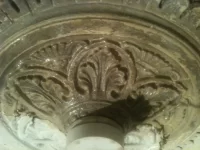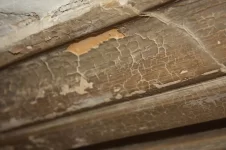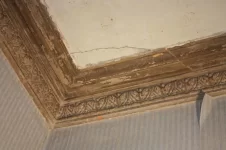Hi
Couple of questions for anyone knowledgeable in victorian plaster;
I'm renovating a 120yo glasgow tenement, currently just stripped the mediumly ornate cornice & rose using stream and unsure how to proceed...all suggestions greatly appreciated!
What is victorian cornice made of/finished - ie: assuming plaster but what are the below layers likely to be?
there are several layers, from external layer on top:
- paint,
- light brown mud-like? (often very thick in places, was in all the grooves/ details etc)
- darker brown thin layer?
- clean brightish orange, almost wood looking, layer showing through in some places - is this the base plaster? - (so far its only come through on the straight sections)
The stripped ornate sections look great & I want to leave them stripped and 'rustic' ie: brown.

but on the straight sections flanking the ornate cornice, the brown layers are flaking - (assuming due to the steam).
- ? Any suggestions how to stablise the flaky brown surface? or do i need to strip this further before finishing. (and if so any suggestions on easy method?)
would a chalk based paint work better? something like earthborn?
- ? And thoughts on whether victorian cornice needs to be sealed (or similar) long term? or can be left bare (baring in mind i dont intend painting)
Dont want it to dry and crumble or anything over time.
(- wondering whether a soft wax might seal and give an interesting finish - like the annie sloans stuff)
Ceiling & Distemper
While I'm asking - the ceiling around it - which i will paint, is in mixed condition. I've stripped the lining paper and its got a few cracks and stippled surface in places, but hopefully seems stable. I was going to get it skimmed but the Plasterer reckons its distemper - its yellow white silkish paint, grey beneath and assuming its over lath - so skimming might not be best anyway.
So looking for a quicker, 'rustic' fix to get the job done, if there is one......?
I've seen a thick 'no more cracks' ceiling paint - anyone used it? any good?
whats the latest on distemper - will any of the modern paints stay over distemper? - or one of the interior sealers I've seen mentioned on here first?
or again would a chalk paint work better?
Many Thanks!
Couple of questions for anyone knowledgeable in victorian plaster;
I'm renovating a 120yo glasgow tenement, currently just stripped the mediumly ornate cornice & rose using stream and unsure how to proceed...all suggestions greatly appreciated!
What is victorian cornice made of/finished - ie: assuming plaster but what are the below layers likely to be?
there are several layers, from external layer on top:
- paint,
- light brown mud-like? (often very thick in places, was in all the grooves/ details etc)
- darker brown thin layer?
- clean brightish orange, almost wood looking, layer showing through in some places - is this the base plaster? - (so far its only come through on the straight sections)
The stripped ornate sections look great & I want to leave them stripped and 'rustic' ie: brown.

but on the straight sections flanking the ornate cornice, the brown layers are flaking - (assuming due to the steam).
- ? Any suggestions how to stablise the flaky brown surface? or do i need to strip this further before finishing. (and if so any suggestions on easy method?)
would a chalk based paint work better? something like earthborn?
- ? And thoughts on whether victorian cornice needs to be sealed (or similar) long term? or can be left bare (baring in mind i dont intend painting)
Dont want it to dry and crumble or anything over time.
(- wondering whether a soft wax might seal and give an interesting finish - like the annie sloans stuff)
Ceiling & Distemper
While I'm asking - the ceiling around it - which i will paint, is in mixed condition. I've stripped the lining paper and its got a few cracks and stippled surface in places, but hopefully seems stable. I was going to get it skimmed but the Plasterer reckons its distemper - its yellow white silkish paint, grey beneath and assuming its over lath - so skimming might not be best anyway.
So looking for a quicker, 'rustic' fix to get the job done, if there is one......?
I've seen a thick 'no more cracks' ceiling paint - anyone used it? any good?
whats the latest on distemper - will any of the modern paints stay over distemper? - or one of the interior sealers I've seen mentioned on here first?
or again would a chalk paint work better?
Many Thanks!


